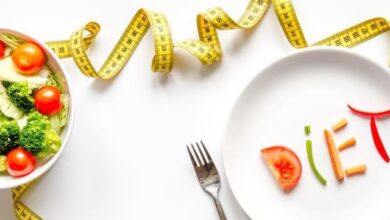Health Tips: Increasing Nutrients in Rice – A great way to improve nutrition and health. 1 News Track English

[ad_1]
Health Tips: Food has the ability to protect against diseases and cure diseases. Understanding this, around 400 BCE the omniscient Hippocrates said in his concept, ‘Let food be your medicine and medicine your food.’ Modern advances and research provide ample evidence to conclude that in functional foods and nutrition; Has the ability to modulate and modulate the immune response and protect against infection. A healthy diet, with balanced nutrients, can neutralize free radicals produced naturally and caused by the environment. Free radicals cause oxidative stress in many parts of the body, which lead to pathological conditions and modern medicine compensates for the damage caused by it. Antioxidants in a healthy diet neutralize free radicals and prevent cell damage, thus stopping disease before it begins, eliminating the need for drugs. Food has always been and will be a powerful tool in building a healthy society.
Consequences of malnutrition limited only to health standards
The unavailability of a varied and balanced diet leads to malnutrition, which can lead to many adverse consequences associated with human health and physical conditions, such as intellectual disabilities, congenital disabilities, blindness, etc. The consequences of malnutrition are not limited to health standards, but it also affects productivity and economy by causing physical and mental challenges. Malnutrition is a chronic problem and has always been a challenge to public administration and public welfare, which hinders the economic prosperity of a developing country like India. Malnutrition is a serious challenge for children, women and people living below the poverty line. In a country like India of 136 crore people, whose dietary system is dominated by carbohydrates, ensuring the availability of naturally diverse food to every individual is a colossal task.
enriching food with nutrients
In such a situation, it becomes necessary to balance the nutrients in the diet with a science-based approach. The need is felt to equip the food with nutrients. Experts agree that fortifying food with nutrients is the recommended way to prevent and control micronutrient deficiencies in people. Other recommended measures are organically increasing the nutrients in food products and supplemental nutrients. Nutrient enrichment of food products is the process of thoughtfully adding vitamins, minerals and other nutrients to enhance its nutritional quality. Biologically enhancing nutrients in food products is an application of plant breeding techniques, in which micronutrients are increased in major food grains. In contrast to the process of fortifying food with nutrients, biologically enhancing the nutrients in food products is a long-term strategy that requires substantial upfront investment. The estimated cost per person per year for the process of nutrient enrichment is $0.12 per person, while the cost of biologically growing nutrients in rice in India is $1,600,000 per year (nationally, total). The process of supplemental nutrient supply carries the risk of over-consumption, whereas the process of increasing the nutrients in staple foodgrains under a controlled process is considered the most efficient and economical method of nutrition. In developed countries such as Europe and the Americas, programs to increase the nutritional value of food products have successfully eradicated micronutrient deficiency diseases such as goiter, cretinism, pellagra, rickets and xerophthalmia, which are known to cause morbidity and death in children. attributed to the high level of the rate.
65 percent of the population consumes rice
About 65 percent of India’s population consumes rice as their staple food. India is the second largest producer of rice, and rice processing mills remove about 10 to 12 percent of the total quantity of rice as a by-product of broken rice during processing. The rice fortification process uses these broken rice grains as a carrier to deliver essential micronutrients to a large number of people, especially low-income populations, without any dietary and behavioral changes. Flour is made by grinding broken rice grains, mixing that flour with a premix of vitamin-mineral ingredients, and then the mixture is converted into rice-sized kernels commonly known as ‘fortified rice kernels’. (FRK)’. This FRK is mixed with normal rice in the ratio of 1:100 to achieve the micronutrient concentration prescribed by FSSAI. The indigenous process developed by IIT Kharagpur has solved the pre-existing problems associated with differences in colour, size, density, functional and cooking properties of FRK as compared to native rice. The process of extrusion retains and stabilizes the micronutrients better. This process also provides an economical alternative for better implementation of the strengthening programme.
For effective implementation of this programme, the production process of FRK and its blending with normal rice should be carried out under continuous monitoring, quality assurance and control and corrective measures to be taken with a view to ensure high compliance. There should be suitable measures and standards related to GMP, GHP to avoid over or under dosage of these micronutrients. Like any other food processing industry, this program requires stringent standards and regulations and constant monitoring of its effectiveness to maintain its effectiveness. The highest level of standard has been suggested. Consumption of micronutrients in amounts slightly above the upper limit has been shown to have a low risk of adverse effects. It is important to understand here that even life saving drugs can prove fatal if taken in excess of the recommended limit. Therefore, it is imperative to implement appropriate limits and corrective actions to control this program of consolidation. Since the 1940s, the United Kingdom has equipped wheat flour with iron and other important nutrients. Countries such as Turkmenistan and Uzbekistan have mandated nutrient enhancement in wheat flour (FFI). The Canadian government has used the mandatory step of nutritional enhancement to eliminate problems such as goiter and rickets. In view of the past experience, the problem of micronutrient deficiency can be avoided and controlled by increasing the nutrients in food on a large scale through nutritionally specific and sensitive efforts.
Rice is a staple diet in India
In conclusion, it can be said that the promotion of nutrients in food is an economically viable and technically sound way to manage malnutrition. Rice is a staple food in India and is consumed by people of all socio-economic classes. Enriching rice with iron, folic acid and vitamin B12 is a new and sustainable way to address the problem of Iron Deficiency Anemia (IDA) in the country. The initiative taken by the Government of India towards increasing the nutrients in rice and supplying that rice to the public through the Public Distribution System (PDS) is highly commendable.
(These are the personal views of the authors.)
1. Dr. H. N. Mishra,
Professor (HAG) & Principal Investigator
Rice Fortification Project
Department of Agriculture and Food Engineering, Indian Institute of Technology, Kharagpur
2. Dr. C G Dalbhagat, Project Officer
Rice Fortification Project
Department of Agriculture and Food Engineering, Indian Institute of Technology, Kharagpur
3. Ms. A. Nitya, Senior Research Fellow
Rice Fortification Project
Department of Agriculture and Food Engineering, Indian Institute of Technology, Kharagpur
.
[ad_2]






